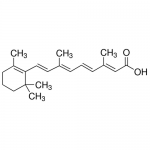| Product Name | Retinoic acid |
| Description |
Retinoid RAR agonist |
| Field of Use | Not for use in humans. Not for use in diagnostics or therapeutics. For in vitro research use only. |
Properties
| Solubility | Soluble to 50 mM in ethanol and 25 mM in DMSO |
| Appearance | Yellow solid |
| Safety Phrases |
Classification: Toxic. May be harmful or fatal is inhaled, swallowed or absorbed through skin. Safety Phrases: S22 - Do not breathe dust S24/25 - Avoid contact with skin and eyes S36/37/39 - Wear suitable protective clothing, gloves and eye/face protection Risk Phrases: R20/21/22 - Harmful by inhilation, in contact with skin and if swallowed R40 - Limited evidence of a carcinogenic effect R46 - May cause heritable genetic damage R62 - Possible risk of impaired fertility Hazard Phrases: H302-H411 Precautionary Phrases: P273 |
| Cite This Product | Retinoic acid (StressMarq Biosciences, Canada, Cat # SIH-258) |
Biological Description
| Alternative Names | Tretinoin, ATRA |
| Scientific Background | Retinoic acid, a metabolite of vitamin A, plays a critical role in neural development and differentiation. It regulates gene expression by activating nuclear retinoic acid receptors (RARs), which influence neuronal patterning, synaptic plasticity, and neurogenesis. In neurodegenerative disease research, retinoic acid has been studied for its ability to promote neuronal survival and regeneration. It is also involved in modulating inflammatory responses and oxidative stress, making it a candidate for therapeutic intervention in conditions such as Alzheimer's and Parkinson's disease. |
| References | 1. Duester G. (2008) Cell. 134: 921-931. |



StressMarq Biosciences :
Based on validation through cited publications.